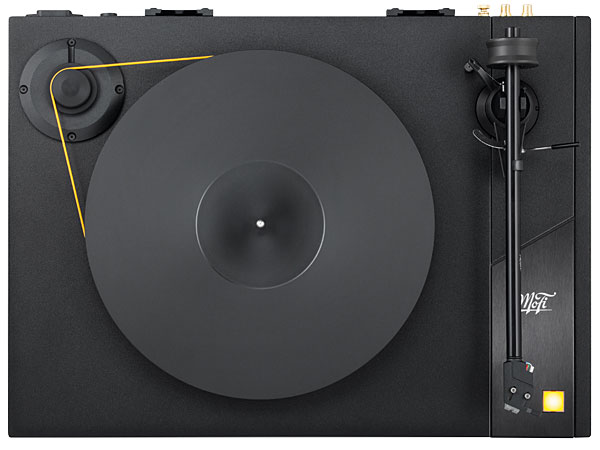MoFi StudioDeck+ Turntable Package Page 2
![]() Fast 'N' Furious
Fast 'N' Furious
All else is the same, the operational involvement consisting solely of an on/off switch on the plinth's lower right hand corner, and speed change from 33rpm to 45rpm achieved by moving the belt on the pulley. Tonearm set-up was limited to balancing the arm, applying tracking force and hanging the anti-skate weight, as the cartridge was pre-fitted in this StudioDeck+ version. I checked the location with my own protractor and it was spot-on, while an electronic stylus balance helped set the StudioTracker to 2g. From box to music? All in all, it took a dozen minutes.
In order to better assess the differences between the StudioDeck and UltraDeck, which is the meat of this review, I used exactly the same recordings. For those of you without access to the earlier review, I am making specific comparisons between them, as this seems the most useful for the potential buyer. And before you ask, no, the StudioDeck doesn't 'blow away' the UltraDeck. But it is to its dearer sibling what Bottas is to Hamilton.
Starting with Silverhead's 1973 release 16 And Savaged [Purple Records TPSA7511], an album that falls under a banner which embraces glam, power pop and hard rock, the desired effect is achieved by a mix of speedy transients, slam and attack. Not, I hasten to add, the grandeur demanded of pompous stadium rock, but certainly a recording that wants to bludgeon the listener.
Sheer Wonder
Now I am not about to attribute these sonic qualities to the actual, physical weight or mass of a record deck, but the UltraDeck had the edge, most noticeably when it comes to the percussion. I wrote before of its militaristic mien, and the substantial 'crunch' that made me wish I owned a pair of late 1960s JBLs. The StudioDeck came close enough to make me try it with the Ortofon 2M Red that I had also used in the UltraDeck.
This confirmed a boast by Bizar that the less-costly unit offered a 'healthy percentage' of the flagship's performance. An imaginary scale might show the percentage improvement by the Ultra to be in single digits. Yes, it came that close.
A simple analogy would be to cite two cartridges from the same family, with increases in price and gains in performance being incremental. You know the drill because it is the definition of an upgrade path. The sheer wonder of the StudioDeck vs the UltraDeck is how perfectly its represents the gains without tickling the feet of the Law of Diminishing returns.
In other words, you will hear every extra pound if you opt for the UltraDeck, but you will still be mightily impressed by what the StudioDeck delivers... enough to wonder if you should dip into your bank account for another grand.

Litmus Test
Raucous rock-ready record decks are plentiful and at tempting prices. Finesse costs more. As with its big sister, the StudioDeck was tested with the most refined recording I could muster, Dusty Springfield's 'The Look Of Love' on a 12in single from Classic Records [CR-5005-12]. This really is 'all about the voice' and Dusty's breathy delivery – arguably the sexiest since Julie London circa 1958. The StudioDeck demonstrated remarkable low-level detail, and came so close to the UltraDeck for delivering scale and 'air' that
I was struck by the thought that the cartridge variances were greater than that of the turntables, though the UltraDeck sounded warmer.
Of late, I have been relying on The Band's eponymous second LP [MFSL 1-419], and cannot wait to get my hands on the just-released 50th anniversary edition. That possibly superior release aside, MoFi's version is as good as it gets, and it was somehow appropriate that I try the StudioDeck with at least one MoFi title. As before, Levon Helm's expressive drumming – always a litmus test for sonic precision – and Garth Hudson's majestic Lowrey organ proved particularly illustrative.
Again, the StudioDeck had a slightly 'lighter' sound, though I cannot say it lacked substance. It was more a case of quality rather than quantity, and one can tell that the same ears 'voiced' both. If I had to reduce the sibling rivalry to a high concept analogy, the differences are on a par with buying 'the next amp up' in a range of integrated amps: same sonic signature, but slightly more punch. The difference here, though, is the massive savings.
One final observation: even more so than the UltraDeck, the StudioDeck justifies the addition of one particular accessory, which is a record weight, or clamp. MoFi's own 'superheavyweight' eliminated a trace of 'woof' in the mid-bass, and had the unanticipated benefit of lowering surface noise. I also played around with felt, rubber and cork mats, and the StudioDeck proved transparent and coherent enough to reveal the differences with repeatable results. This is my way of saying that the StudioDeck actually encourages tweaking, the UltraDeck less so because it has the edge in ultimate refinement.
Hi-Fi News Verdict
MoFi has done its homework and produced a gem of a basic deck. I was not prepared for such an instant dose of sheer delight. You all know the sensation when caught unawares by a product that defies its price category with magical sounds, and the StudioDeck is one of them. For nervous newcomers in sore need of a user-friendly, painless introduction to proper vinyl playback, this is a no-brainer.
























































